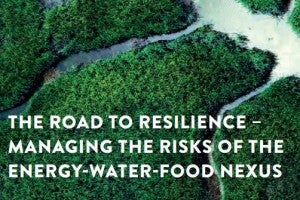 You probably have some sort of insurance – for your healthcare, car, house, or apartment. Acting on climate change is also like insurance. It is all about managing the risks.
You probably have some sort of insurance – for your healthcare, car, house, or apartment. Acting on climate change is also like insurance. It is all about managing the risks.
We can’t know for certain what the future brings, but recent research predicts a 40 percent shortfall of available water across the globe by 2030. In the face of this prediction, a new report from the World Energy Council, “The Road to Resilience – Managing the Risks of the Energy-Water-Food Nexus” helps lay some groundwork to ensure we plan for the climate risks that will affect our most essential resources.
I have talked about the reliance of energy on water and water on energy (the energy-water nexus), and touched on their connection to food. But let me make that linkage clearer: 70 percent of available global freshwater is used by the agricultural sector, and energy is the second-largest freshwater user globally after agriculture (although this varies from country to country and region to region). Relatedly, about 15 percent of total U.S. energy demand is for the food sector (this includes both agriculture and processing), and roughly 13 percent of U.S. energy use is for water-related purposes. Read More










 Today is
Today is  San Antonio and Austin just called a
San Antonio and Austin just called a  Symbiosis – in which different species have a cooperative or mutually beneficial relationship – is everywhere in nature: honeybees receive vital nutrients from flowers while delivering pollen (male) directly to the female parts of the flower; pilot fish gain protection from predators, while sharks gain freedom from parasites; and dogs protect their owners, while receiving food and shelter. Cited by
Symbiosis – in which different species have a cooperative or mutually beneficial relationship – is everywhere in nature: honeybees receive vital nutrients from flowers while delivering pollen (male) directly to the female parts of the flower; pilot fish gain protection from predators, while sharks gain freedom from parasites; and dogs protect their owners, while receiving food and shelter. Cited by 
